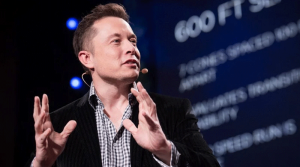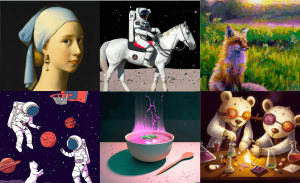DALL-E-2 is an artificial intelligence system developed by OpenAI that is capable of generating highly realistic images from text descriptions. Using a combination of deep learning algorithms and natural language processing techniques, DALL-E-2 can take a textual description of an object or scene and generate a corresponding image that matches the description with impressive accuracy.
What makes DALL-E-2 so groundbreaking is its ability to create images of objects and scenes that don’t exist in the real world. For example, it can generate images of a “red armchair in the shape of an avocado” or a “giraffe wearing a cowboy hat.” This opens up a whole new realm of creative possibilities for designers, artists, and other creative professionals.

DALL-E-2 builds on the earlier version of the system, DALL-E, which was released in 2021. However, DALL-E-2 boasts several key improvements, including the ability to generate higher-quality images and more complex scenes with multiple objects.
Overall, DALL-E-2 represents a major breakthrough in the field of artificial intelligence and has the potential to revolutionize the way we think about image generation and creative expression. In the rest of this article, we’ll take a closer look at how DALL-E-2 works and some of its most interesting applications.
How DALL-E-2 Works
At its core, DALL-E-2 is a deep learning neural network that uses a combination of computer vision and natural language processing to generate images from text descriptions. The system is trained on a large dataset of images and corresponding textual descriptions, which allows it to learn how to match text descriptions with the appropriate visual features.
The neural network architecture of DALL-E-2 is based on the GPT-3 language model, which is known for its ability to generate high-quality text responses to natural language prompts. This architecture consists of multiple layers of interconnected nodes, each of which processes a different aspect of the input data.
To generate an image from a text description, DALL-E-2 first processes the text input using a transformer network, which converts the words into a set of latent vectors that represent the semantic meaning of the text. These vectors are then combined with a set of noise vectors to create a “code” that serves as the input to the image generation module.

The image generation module consists of a series of generative adversarial networks (GANs) that work together to create a high-quality image that matches the input text description. The GANs are trained to compete against each other, with one network generating fake images and another network trying to distinguish between real and fake images. This process helps to ensure that the generated images are as realistic as possible.
Overall, the combination of natural language processing and computer vision techniques, along with the GPT-3 architecture and GAN-based image generation, allows DALL-E-2 to generate highly realistic images from text descriptions with impressive accuracy. However, the system is still limited by the quality and diversity of the training data, and further research is needed to improve its performance even further.
Also Read :- Spotify DJ Launches AI-Powered DJ Feature for Personalized Music Experience
Applications of DALL-E-2
DALL-E-2 has a wide range of potential applications, particularly in creative fields such as design, advertising, and entertainment. Here are some of the most interesting and useful use cases for this groundbreaking technology:
- Creating realistic images of objects that don’t exist in the real world: One of the most impressive capabilities of DALL-E-2 is its ability to generate images of objects and scenes that are completely imaginary. This could be particularly useful in industries such as product design, where designers could use the technology to visualize and prototype products that haven’t been created yet.
- Generating images for marketing and advertising: DALL-E-2 could also be used to create high-quality images for marketing and advertising purposes, particularly for products that are difficult to photograph or depict in traditional ways. For example, a company could use DALL-E-2 to create images of a new flavor of ice cream before it has been produced, allowing them to market the product before it’s even available.
- Augmenting virtual and augmented reality experiences: DALL-E-2 could be used to create more realistic and immersive virtual and augmented reality experiences by generating detailed and accurate images of objects and scenes. This could be particularly useful in fields such as gaming, where realistic graphics are essential to creating an engaging experience for players.
- Improving accessibility for people with visual impairments: DALL-E-2 could be used to generate images that describe visual scenes and objects for people with visual impairments, making it easier for them to understand and navigate their surroundings.
Overall, the potential applications of DALL-E-2 are vast and varied, and the technology is sure to have a major impact on many different industries in the years to come.
Also Read :- Xiaomi Unveils MIUI 14 Global Release for 12 Flagship Devices: Experience the New Android 13-based UI
The Future of OpenAI DALL-E-2
As impressive as DALL-E-2 is already, there is no doubt that the technology will continue to evolve and improve in the years to come. Here are some potential new applications and improvements that we might see in the future:
- Improved image resolution and fidelity: One area where DALL-E-2 could see significant improvement is in the quality and resolution of the generated images. As hardware and software continue to advance, it’s likely that the technology will be able to create even more realistic and detailed images.
- Expanded training data and vocabulary: Currently, DALL-E-2 is limited by the quality and diversity of the training data that it has access to. As more data becomes available, and as the technology improves in its ability to understand natural language prompts, we may see the vocabulary and complexity of the generated images increase.
- Integration with other AI technologies: DALL-E-2 could be combined with other AI technologies such as voice recognition and machine translation to create even more seamless and integrated experiences. For example, a user could describe an object in one language, and DALL-E-2 could generate an image of that object in real-time, while also translating the description into another language.
- New applications in healthcare and education: DALL-E-2 could be used in healthcare and education to create visual aids and educational materials. For example, doctors could use the technology to generate images of complex medical conditions or procedures to help patients better understand their diagnoses and treatments. Similarly, educators could use DALL-E-2 to create interactive visual aids to help students learn complex concepts.
Overall, the future of DALL-E-2 is exciting and full of potential. As the technology continues to improve and expand, we are sure to see even more innovative and groundbreaking applications in a wide range of fields.

Ethical Considerations of DALL-E-2
As with any new technology, DALL-E-2 raises a number of ethical questions that must be considered. Here are some of the most important ethical considerations to keep in mind when it comes to this groundbreaking AI:
- Potential for misuse: One of the biggest ethical concerns with DALL-E-2 is the potential for misuse. For example, the technology could be used to generate fake images or videos that could be used to spread misinformation or propaganda. As with any powerful tool, there is a risk that it could be used for malicious purposes.
- Impact on creative industries: Another ethical consideration when it comes to DALL-E-2 is the potential impact on creative industries such as graphic design and photography. As the technology becomes more widespread and advanced, it could potentially replace human creatives in some contexts, leading to job loss and other economic impacts.
- Bias and fairness: As with any AI technology, there is a risk of bias and unfairness in the data and algorithms that power DALL-E-2. For example, if the training data used to create the technology is biased in some way, the resulting images could also be biased or perpetuate harmful stereotypes.
- Privacy concerns: There are also privacy concerns to consider when it comes to DALL-E-2. For example, if the technology is used to generate images of people or personal information, there could be potential privacy implications for those individuals.
Overall, it’s important to approach DALL-E-2 with caution and to consider the potential ethical implications of the technology. By doing so, we can work to ensure that the technology is used in responsible and beneficial ways.
Conclusion
DALL-E-2 is a groundbreaking AI technology that has the ability to generate incredibly realistic and detailed images of a wide range of objects and scenes. Its potential applications are vast, from creating images of objects that don’t exist in the real world to assisting with medical diagnoses and educational materials. However, as with any new technology, there are also important ethical considerations to keep in mind, such as the potential for misuse and impact on creative industries.
Despite these considerations, the future of DALL-E-2 is bright and full of potential. As the technology continues to evolve and improve, we are sure to see even more innovative and groundbreaking applications in a wide range of fields. It’s important that we approach this technology with caution and consideration for its potential ethical implications, but we should also be excited about the possibilities it presents.
In conclusion, DALL-E-2 is a remarkable technological advancement that has the potential to transform the way we create and interact with images. As we continue to explore and develop this technology, we must remain mindful of its potential impacts and work to ensure that it is used in responsible and beneficial ways.
Also Read :- Sundar Pichai : Inspirational Biography, Education, Family and Unexpected Salary of $2M+


